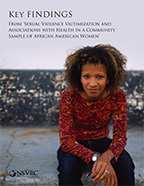
This is a guest post by Karen L. Stahl, NSVRC Technical Assistance Coordinator
A study recently released by the CDC confirms what most advocates already know: the realities and trauma of sexual violence are experienced very differently by the many groups of people victimized. The study is welcomed because as accurately noted, there is substantial literature on the health-related consequences of sexual violence, but little that has focused specially on racial and ethnic minority women.
Using data from a community sample of African American women in an urban southeastern city, this study provided an in-depth examination of the relationship between lifetime rape or sexual coercion victimization experiences and numerous mental and physical health correlates including a snapshot of adverse life conditions that pose additional and consequential burdens.
Highlights *
Based on face-to-face interviews with 168 African American women, this study found high victimization rates which were associated with a broad range of compounding struggles:
- Over half (53%) of women reported rape victimization and 44% reported being sexual coerced in their lifetime;
- Victims of rape and/or sexual coercion were significantly more likely to report symptoms of depression and PTSD during their lifetime;
- Among victims whose first unwanted sexual experience resulted in rape and/or sexual coercion, perpetrators were mostly acquaintances and intimate partners, and over one-third of these victims were injured and needed mental health services.
Additionally, women affirming lifetime experiences with rape/sexual coercion revealed higher levels of substance abuse than those not victimized and more concerns with housing and financial insecurity.
Past studies have highlighted the reciprocal nature of sexual violence: women living in poverty are often in situations that put them at increased risk for victimization; victimization can then increase the risk of unemployment, mental health needs and/or substance abuse which make their ability to find safe or safer living situations incredibly difficult.
The authors acknowledge, “…the added burden of traumatic sexual violence victimization for women living in poverty potentially exacerbates the need for multiple services and resources to address various intersecting problems (i.e., poverty, victimization, mental and physical health).” For me, this was a central finding. For all that’s been written and researched over decades about the potential harm and consequences of sexual violence victimization, what if your living experiences and struggles were so overwhelming that sexual violence wasn’t even at the top of the list?
The question becomes: How high can you build a wall and still expect people to climb over it?
But many do. Drawing on strengths and aspirations that come from within their communities - faith, families, and traditions, people do find their way back. As a culture, however, we don’t make it easy. We don’t trust people to know what they need. We make half-hearted gestures and move on quickly when we don’t see immediate results.
While this study will not reflect the experiences of all African American women (one study can never represent the totality of any group of people), the disproportionate number of African American communities experiencing significant levels of poverty, housing and food insecurity, and tenuous connections to resources, it’s likely true for many. When it’s a possibility for even a few, this disparity is a call to advocacy.
Good advocacy is both stepping up and standing back and recognizing when the moment is right for each. It could look like:
- Standing with those who know and live in communities that experience multiple and intersecting struggles;
- Developing, partnering with and supporting the call for funding that addresses the realities of many lives where victimization happens;
- Recognizing that trauma can be experienced—and expressed—differently: healing efforts may look different and will be led by the strengths and aspirations that come from the community;
- Supporting leaders in the community whose work and messages reflect positive, affirming community norms.
As we noted in our translation paper, (p.8) “Responding effectively has to occur within the larger realities of victims/survivors and their communities that are often impacted by racism, classism, and other forms of oppression.” The broad effort needed to address victimization in marginalized communities is the only just and legitimate response.
* Please note: research studies should always be taken in context, and reviewing the study, methods and limitations is helpful in interpreting data. Draw your own conclusions.
The Study:
Sexual Violence Victimization and Associations with Health in a Community Sample of African American Women. Basile, Smith, Fowler, Walters, and Hamburger (2016)
The Translation:
Key Findings from Sexual Violence Victimization and Association with Health in a Community Sample of African American Women. National Sexual Violence Resource Center (2016)
